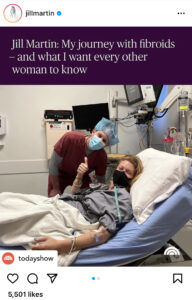Did you know that sometimes, fibroids cause back pain? If you’ve been diagnosed with fibroids, you probably know that they are non-cancerous tumors that grow in your uterus. And, chances are, you experienced some fibroid symptoms before that diagnosis. Maybe your periods were really heavy. Or perhaps you experienced chronic pelvic pain. 
But if your fibroid symptoms include back, leg and stomach pain, you might wonder: how could uterine growths hurt in so many other places?
Don’t worry, you’re not alone. Diffuse pain is a common fibroid symptom. That's because fibroids can put pressure on your sciatic nerve, leaving you with back pain, as well as radiating pain in your hips, buttocks, and legs. It can be scary when you feel these symptoms all over, but we’re here to help you understand how uterine fibroids spread symptoms to the rest of your body. And why fibroids cause back pain. But first, let's talk about Today Show contributor Jill Martin. Because she just came forward to talk about fibroid pain's impact on her life.

A few months ago, NBC presenter Jill Martin started getting messages asking if she was pregnant. But she wasn't. Instead, she had fibroids, and the size of her uterine growths made her look like she was carrying a baby.
Sadly, that wasn't Jill's only symptom. She experienced painful sex, and her fibroids also started causing body pain. For a while, she tried to push through the discomfort. Eventually, the pain increased to the point where she couldn't come to work.
Fortunately, Jill researched her treatment options, and discovered Uterine Fibroid Embolization, or UFE. Now, shortly after treatment, she's experiencing less pain and her bloating is improving. Plus, she's sending an important message. Even when fibroids cause back pain or other disruptive symptoms, you have several pain-relief options. As she tells Today, "Before discovering this treatment, I thought the only way to fix my pain meant getting a hysterectomy. After talking with other women who suffer from fibroids, I realized I'm not alone — many of them thought that a major surgery to remove their uterus was their only real solution, too. But there are other options. And when you are in pain, more often than not, it is time to do something."

Like we said, you’re not alone with your fibroid-related back pain. In fact, a study in the Journal of Fertility and Sterility reported 60% of women with fibroids experience lower back pain, and 22% have stomach pain. Another 25% experience other abdominal problems, including diarrhea, constipation and/or bloating.
So, what’s the connection between your fibroids and all this widespread pain? Here’s the story:
Fibroids can change the shape of your uterus, making it press up against other parts of your body. Or, fibroids can grow outside your uterus, so the tumors themselves press against the nerves in your spine, or against your rectum or bladder. And, if any of that happens, well guess what? You’re likely to experience the types of symptoms we just mentioned.
For example, if your fibroid presses on a nerve or vein in your lower back area, your legs, hips, and back could all be affected. You might even experience leg swelling, or find it difficult to stand for long periods of time, if the fibroid presses on your blood vessels.
Every woman's symptoms are unique. And, your pain will feel different based on the size and location of your fibroids. With growing fibroids, you're likely to experience dull, chronic pelvic pain. Or, you'll experience discomfort, heaviness and pressure. But if you have a fibroid that's deteriorating, your pain could be sharp, severe and localized in one spot. As such, there's no one way to answer, “What does fibroid pain feel like?”
At the same time, it is completely normal for your fibroids to give you pain, along with other symptoms such as heavy bleeding, fatigue and anemia. While these symptoms are a "normal" part of the fibroid experience, they aren't something you have to live with forever. Relief is available, and sooner than you think!
When fibroid pain affects so many body parts, it can interfere with your daily life. If you’re in that position, you’re likely researching fibroid treatment options. And it’s important for you to know that surgery isn’t your only option.
While some women will choose to undergo myomectomy (surgical removal of fibroid tumors), you may wish to avoid this invasive procedure. If so, make sure you learn more about uterine fibroid embolization (UFE), a minimally invasive procedure we perform at our Houston fibroids practice.
It's often a better choice than hysterectomy, which triggers major side effects, including bone loss, memory loss
With this procedure, our physicians use catheters to access your fibroid’s blood supply, cutting off the flow with a permanent deposit of embolic material. After UFE, your fibroids shrink or even disappear completely. And once that happens, you will likely experience relief from back and leg pain, along with other unpleasant fibroid symptoms.
But that’s not all: because UFE is minimally invasive, you can avoid general anesthesia and likely won’t need to stay in the hospital overnight. And, because UFE only requires a small incision in your arm, your recovery time is much faster than with a procedure like hysterectomy or even myomectomy. Plus, UFE procedures have a very high success rate, meaning your relief should be lasting.
Ready to find out more? If you’re considering UFE, and aren’t sure if its right for you, we’re here to help. We provide consultations to help you learn more about your best fibroid treatment option. So make an appointment with us today!
Sources: USA Fibroid Centers, Journal of Fertility and Sterility
As leading fibroid specialists in Houston, we can help you get back to doing the things you love – free of pain and symptoms associated with this diagnosis.

Scheduling
Please contact our dedicated specialists to schedule a consultation today.
2025 Houston Fibroids. All rights reserved. Website Design by Healthcare Success